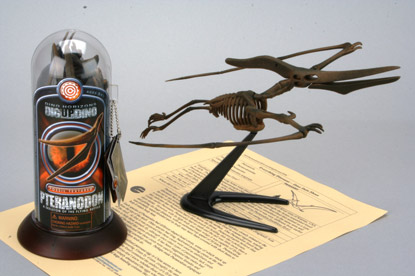Amateur Palaeontologist Claims “World’s First Pterosaur Embryo”
CT Scan reveals Prehistoric Animal Embryos in Fossilised Eggs
Amateur palaeontologist and dinosaur enthusiast Dr Neal Naranjo was given quite a surprise when he had part of his extensive fossil collection subjected to CT scans, an egg from his collection, may contain the fossilised remains of a pterosaur embryo. If this turns out to be true, then this would be the first evidence of a flying reptile embryo discovered to date.
Pterosaur Embryo
Pterosaurs are an extinct group of flying reptiles. Their wings were formed out of skin that stretched from the body over the forelimbs and along an elongated fourth finger of each hand. These creatures evolved in the Triassic and survived until the end of the Cretaceous Period, some sixty-six million years ago.
Texas resident, Dr Naranjo whose ambition is to open a natural history museum, took six eggs from his collection, all thought to be dating from the Cretaceous; but from a variety of different reptiles, to a local medical centre to have them scanned by a CT scanner so that their contents could be seen. To his surprise, five of the eggs showed signs of containing the preserved remains of a baby prehistoric animal.
A CT (stands for computerised tomography) scanner sends out a series of powerful X-rays and enables researchers to build up a three-dimensional picture of the internal structure of an object. Normally, such machines are located in hospitals or universities and provide information to doctors and other practitioners with regards to medical matters, but the strong X-rays can also penetrate rock and enable palaeontologists to see inside a fossil without having to dissect it.
CT Scans
CT scanners are used quite frequently by palaeontologists, for example, the giant Dorset pliosaur fossil is currently being scanned to build up a more complete picture of the internal structure of this huge predator’s jaws and skull.
To read more about the Dorset Pliosaur: Giant Pliosaur Fossil goes for a CT Scan.
When asked why, he sent the eggs for scanning, Dr Neal stated:
“I had these eggs, and I was always curious and wondering if something was inside.”
Although the pterosaur embryo has still to be formerly examined by museum specialists, if this specimen does prove to be the fossil of a baby pterosaur still within its egg, it will be the first such find known to science.
Pterosaur fossils are exceptionally rare, their pneumatised bones, although strong, are rarely preserved and we at Everything Dinosaur are only aware of a handful of pterosaur eggs being known from the fossil record.
A Model of a Late Cretaceous Pterosaur (P. longiceps)

Picture credit: Everything Dinosaur
The picture shows a model of a fossilised skeleton of a Late Cretaceous flying reptile. The kit is available to purchase online from Everything Dinosaur.
To view the range of pterosaur and dinosaur themed toys and gifts available: Visit Everything Dinosaur.
Pterosaur Eggs
Some scientists believe that pterosaur eggs were pliable, like extant turtle eggs and as they were more leathery then they would only survive the fossilisaton process in very rare instances. Also, many pterosaur species are associated with marine sediments and like seabirds today, they may have chosen out of the way, rocky islands and cliff tops on which to nest, so material from such sights would be very unlikely to have been preserved as fossils.
Describing the moment when the images of the baby pterosaur first became apparent, Dr Naranjo said:
“When we saw it, we started yelling and screaming and jumping up and down and going ‘it’s a baby, it’s a baby'”.
Dr Naranjo has already received enquiries from a number of palaeontologists from the USA and Europe requesting that they be given the opportunity to examine the fossil in more detail. He intends to take this specimen to the animal Tuscon Mineral and Fossil Show, so that experts can view it.
Although, most of the eggs scanned had been purchased, Dr Naranjo had found one specimen himself and this particular fossil egg contained the preserved embryo of a bizarre theropod called a therizinosaur (Scythe Lizard).
Commenting on the successful use of the Medical Centre’s CT scanner, Radiology Director Rebecca Petty said:
“We were all excited, for us to get to help in something like this was amazing.”
In addition to the eggs, Dr Naranjo brought in fossils from a Hadrosaur (duck-billed dinosaur) he had found in Montana. The dinosaur had been bitten in the leg during its lifetime, and the doctor was curious to see what they could learn from the bite wound (the study of infections and wounds in fossils is referred to as pathology). The CT scan revealed that the dinosaur had suffered from an infection that went all the way to the bone marrow. Despite the infection, the dinosaur survived.
Dr Naranjo’s extensive fossil collection, including the eggs, will help form part of the collection for the Naranjo Natural History Museum, due to be sited in the town of Lufkin (Texas). It has long been an ambition of Dr Naranjo to help establish a natural history museum in the area, and a few weeks ago his plans were given the go ahead.
For models and replicas of pterosaurs and other prehistoric animals: Pterosaur and Prehistoric Animal Models.

